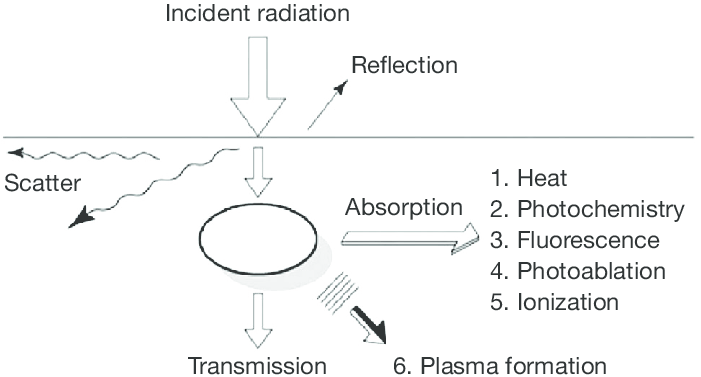The Principle of Laser Tissue Interactions in Dental Treatment
Biomedical applications of lasers have been under investigation since Theodore Maiman used the first Ruby laser in 1960.
The laser beam is, due to its monochromaticity (single wavelength), coherence (photons in phase), collimation (very low beam divergence) and intensity, highly precise and selective in interaction with biological tissues. When a laser beam interacts with tissue, it can be reflected, transmitted, scattered and absorbed in varying proportions. The absorbed laser energy is particularly important because it transforms into thermal energy and causes changes inside the tissue. The total amount of laser energy, which will be absorbed, depends on the laser wavelength and the optical characteristics of the target tissue, such as pigmentation (chromophores) and water content. The effect of the absorbed laser energy in the target tissue can be controlled by the irradiation parameters: 1) irradiance or pulse energy; 2) mode of energy emission (continuous wave (cw) or pulse irradiation); 3) laser beam size on the tissue; 4) laser pulse length and repetition rate; 5) the use of water spray. In addition, any change in the physical properties of the tissue, as a result of laser irradiation with certain parameters, can also influence the effect of the laser tissue interaction.
Potential benefit of lasers in medicine and dentistry depends on the particular properties of each type of laser and the specific target tissue. The physical properties of the tissue (absorption and scattering coefficient, thermal conductivity, mechanical strength, heat capacity) and laser irradiation parameters govern the course of laser-tissue interactions. At low irradiances and/or energies, laser tissue interactions are either purely optical, or a combination of optical and photochemical or photobiomodulative effect. When laser power is increased, photothermal interactions start to dominate. Finally, photomechanical (sometimes referred to as photoacoustic) effects become apparent when repetitive and very short laser pulses with high pulse energy are delivered to the tissue.
It can be concluded that laser light irradiation of relatively low intensity during longer time is less destructive than those applied for short-duration at high intensities. Moreover, there is a minimal level or threshold of energy required for specific types of interaction to occur.
